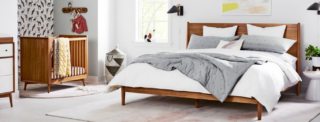- Resources
- How Williams-Sonoma, Inc. is furnishing a better planet
Resources
How Williams-Sonoma, Inc. is furnishing a better planet
Published: March 14, 2019 by Yesh Pavlik Slenk
Furnishing a new home is a big job. I know because I recently went through the process myself. You need to purchase the big ticket items, maybe a new bed from Pottery Barn, down to the nitty-gritty items, possibly a nice west elm throw for the couch. It’s taxing work – for you and the planet.
Danielle Jezienicki, Director of Corporate Social Responsibility at Williams-Sonoma, Inc. works across the company’s eight brands, including Williams-Sonoma Home, Pottery Barn Kids and PBTeen, west elm, Rejuvenation and Mark & Graham, to ensure that products are made with the environment in mind.
I recently spoke with Danielle, an EDF Climate Corps and Presidio Graduate School alumna, to learn how Williams-Sonoma, Inc. works with stakeholders from customers, employees and vendors to engrain sustainability into its values.
Here’s an edited version of our conversation.
How do you approach overseeing CSR not just for one company, but for eight separate brands?
I’ve always been very interested in the concept of how brands connect with customers, and how we can integrate sustainability practices through that lens. My time is spent identifying the founding principles for each brand as they relate to their customers, and how to make sustainability part of that dialogue while ensuring each brand is on track to meet broader organization-wide goals. When working with a family of brands, the challenge is figuring out how make CSR relevant to stakeholders in a way that meaningfully improves, changes or influences corporate behaviors, yet still resonates with each individual brand in a way that doesn’t feel forced.

How do you approach goal-setting?
I wish I could say that goal-setting is this formal process that follows a project-management playbook, but it’s not. We are eight brands brought together under one umbrella, so we have to figure out what’s cohesive to all of them and material to our global organization before a goal can be set. It’s a conversation about where our material impact is, what our supply chain looks like, where the industry is as a whole, and then what are we tracking internally and feel comfortable making public. Goals create their own accountability, and that’s been really helpful.
It’s also important to get support from the top. Rather than housing sustainability separately as a silo within the organization, it’s integrated in Williams-Sonoma, Inc.’s sourcing team, not to mention values and corporate mission.
How are customers influencing sustainability at Williams-Sonoma, Inc.? What are they asking for?
Our customers are at the forefront of our thinking. We’re in an ongoing conversation about what they care about so that we can try to get ahead of it. We really want to bring them along on our journey and demonstrate that sustainability doesn’t require a trade off, but rather drives the quality of each product they bring home.
Customer demands look really different at each brand. For example, Pottery Barn Kids customers are bringing a newborn home for the first time, and are shopping with us because they want a safe and non-toxic nursery. West Elm has woven sustainability and ethical, handcrafted production into who they are as a brand, which has really been supported and driven by its customers.
Supply chain and our employees are the other two stakeholder groups that we consider when setting targets. Whether it’s investing in a vision screening program or workforce empowerment, we feel we have a real opportunity to influence people’s well-being and demonstrate the retail sector’s potential for positive influence.
How does Williams-Sonoma, Inc. incorporate sustainability throughout its entire supply chain?
Our work is complex and cross functional, we need to keep an eye towards each step in the production process to understand the role sustainability goals may play, and who needs to be on board to make sure that they are met. This requires communicating about the benefits of sustainability at each phase of the process, from design, to merchandising, sourcing, production and marketing.
Let’s say we look at the life of a towel. Our job as sustainability practitioners starts at the design phase, to ensure that the designers are aware of the sustainable material operations at their disposal, like Tencel, which is a low-emissions, less resource-intensive material made of FSC-certified eucalyptus fiber. Merchants must support this decision from a pricing perspective, so that the sourcing team can work with vendors to make a finished, certified product. The benefits are also shared with brand packaging and marketing teams so that the finished product packaging explains to customers how these materials will benefit them or the environment.
We’re also exploring opportunities for improving vendor practices and incorporating social or environmental initiatives throughout our supply chain. For example, as we transition to reach our 100% responsibly sourced cotton goal, we need our vendors to join us in this journey, adopt the appropriate certifications and ideally drive a more responsible retail industry by offering more sustainable options.
How do you ensure that climate-related projects make it over the finish line?
We’re a very lean team, and we can’t achieve what we do alone. Our work requires finding champions within our eight brands and forming partnerships with them. For every project, we map out the different internal groups or people that we need to work with and somebody who is personally invested or whose work overlaps with ours. Then, we find common ground or shared ownership with that person or department and align our goals with theirs to create either internal or public-facing targets.
It’s important to drive progress and try to do your best to make sure that the sustainability projects aren’t the first to get cut when teams get busy and budgets get tight, but rather cross-cutting internal initiatives that move forward.
Follow Yesh on TwitterFollow EDF+Business on Twitter
